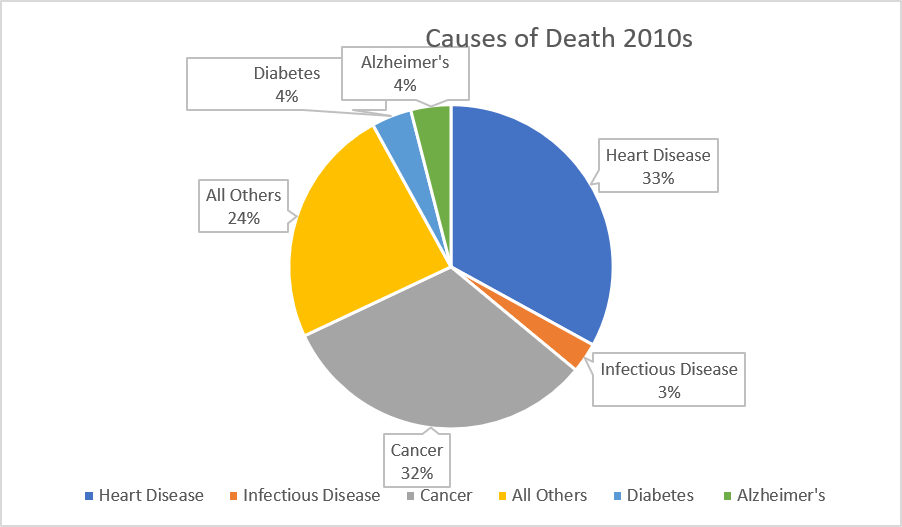How Unhealthy Are Americans?
While I was writing my last post, I was looking at some data relating to our nutritional and health status from the past, and the paper entitled “Prevalence of Optimal Metabolic Health in American Adults: National Health and Nutrition Examination Survey 2009–2016” published in the February 2019 issue of Metabolic Syndrome and Related Disorders shocked me with the findings. You can read it here. They based their conclusions on seven years of data collected on over 8,700 individuals. The authors’ conclusion says it all, “ Prevalence of metabolic health in American adults is alarmingly low, even in normal weight individuals. The large number of people not achieving optimal levels of risk factors, even in low-risk groups, has serious implications for public health.”
They looked at several commonly used variables to determine the “metabolic health” of the subjects. They correlated the subjects metabolic health to “health status characterized by levels of metabolic indicators that are consistent with a high level of health and low risk of impending cardiometabolic disease.” The purpose of their research was to “determine the number and proportion of American adults who have optimal levels of each of five traditional cardiometabolic risk factors in the absence of pharmaceutical treatment.” I will briefly outline the parameters they used.
Waist Circumference
Measuring waist circumference helps screen for possible health risks that come with overweight and obesity. If most of your fat is around your waist rather than at your hips, you’re at a higher risk for heart disease and type 2 diabetes. This risk goes up with a waist size that is greater than 35 inches for women or greater than 40 inches for men. (1)
blood pressure
High blood pressure starts with stage I, which means a reading above 130/80, progresses to stage II with readings above 140/90, and finally, hypertensive crisis, which is readings above 180/120. (2) High blood pressure carries numerous risk factors, including heart attack, stroke, heart failure, kidney disease, vision loss, sexual dysfunction, angina, and peripheral artery disease. (3)
Blood glucose level
Fasting blood glucose levels are normal when below 100mg/dl. Consistently elevated blood sugar can lead to obesity, heart disease, gum disease, cancer, diabetes, liver disease, kidney disease and more. (4)
Hemoglobin A1C
Hemoglobin A1C is a blood test that determines long-term blood sugar status. A reading of less than 5.7% is considered acceptable. The risk factors for elevated A1C are similar to those of high blood glucose. (5)
Triglycerides
Triglycerides are fats found circulating in the blood and should be below 150mg/dl. High levels are associated with strokes and heart attacks. (6)
HDL Cholesterol
HDL, or high density lipoproteins, are considered the “good” cholesterol. It should be above 40mg/dl for men and 50mg/dl for women. Low HDL is a risk factor for heart disease. (7)
The overall prevalence of metabolic health was 19.9% when they allowed blood glucose levels above 100mg/dl. It decreased to 16.0% when they included glucose levels below 100mg/dl. When they added A1C below 5.7%, it dropped to14.8%. Finally, when the blood pressure allowance lowered to 120/80 from 130/85, it fell to a dismal 12.2%.
Using the strictest guidelines, only 12.2% of the population is optimally metabolically healthy! This result is sad and alarming. The pie chart below shows the extent of disease in 1900. Notice the level of heart disease as a killer is at 12%.
Now let's look at the statistics from 2010. We have almost eliminated infectious disease as a major cause of death due to antibiotics, food packaging, refridgeration, and sanitary practices. On the other hand, heart disease is way up; cancer is way up, and diabetes and Alzheimer’s disease account for 8% of deaths now, up from about zero in 1900. Why?
I don’t think we can blame the healthcare system as they are doing the best they can.The triumph over infectious diseases is a great example. Our environment has changed over the last 120 years. We added industrial seed oils, more refined carbohydrates, electrified our homes, adding artificial light at night, massed produced the automobile to become more sedentary, and finally switched from farming to a manufacturing economy. All of this and many more things have created several genetic mismatches that we need to address in our daily lives. For example, we can filter out blue light at night, park far away from work and force ourselves to walk more, stop binging on the internet earlier and get more sleep, and try to avoid cheap processed foods. We need to rely on ourselves to implement the changes we need to take back our health.
How did we have diabetes, heart disease, and Alzheimer’s under control in 1900, only to let them increase to such alarming levels in the modern medical era? Health can be a complicated subject, but it does not have to be. We can optimize our “numbers” without fancy allopathic interventions. Diets of nutrient-dense whole foods, avoidance of processed carbohydrates, adequate sleep, proper movement, and stress management can do the trick. I am not suggesting we stop taking our medication and avoid the doctor. What I am saying is that we need to do a better job of taking care of ourselves. If you want to learn more, follow this link for a quick start guide to better health.










